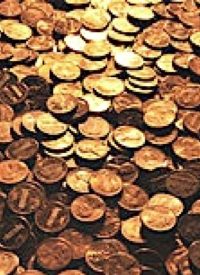
When Jason West of Vernal, Utah, tried to pay his disputed medical bill last week with 2,500 pennies, he was issued a citation for disorderly conduct. The reason for the charge was that West allegedly dumped the pennies onto the cashier’s desk and asked her to count all of them. While the manner in which West delivered his payment may have been a bit extreme (placing rolled coins gently on the desk might have avoided the citation) there was an irony in his case that points to a more important principle than good manners, which are more frequently these days being enforced by the local constabulary, rather than by Emily Post. That is, had he paid the bill with federal reserve notes — backed, really, by nothing more than the promise of the federal government that the paper money has value — then he would have faced no legal problems at all.
Also ironic is the fact that the pennies (known also as “coppers”) have inherent economic value. Gold and silver coins, of course, have value much greater than their face value. The price of copper has risen so quickly that pennies minted before 1982 have a “melt value” of 2.7 cents. Pennies minted in the last three decades have a metal value of only 60 percent of the face value (the copper has been replaced almost completely by zinc).
Our coins didn’t always contain baser metals, however. The American Republic was founded upon the idea of sound money, and the Constitution in Article I, Section 8 lays out most of the relevant language. Congress can “coin money, regulate the value thereof, and of foreign coins, and to fix the standard of weights and measurements” and “…provide for the punishment of counterfeiting the securities and current coin of the United States.”
Sound money meant either species — money made out of metals of value — or paper currency redeemable in exact measurements of money. We are accustomed to thinking of money in the Federal Reserve System sense of one “dollar” being some vague promise by the federal government to support that piece of printed paper. Why use the term “dollar”? What does one “dollar” mean? In our economic system the dollar referred to a physical measurement of gold.
When currency is backed by a clear promise to pay a set measurement of gold in redemption for that currency, then the economy has great inherent stability. Today we take inflation for granted, even to the point of having “cost of living adjustments” in pensions and entitlement spending. We assume that the value of our paper currency, the dollar, will shrink over time. But during the first century of our nation, inflation was essentially unknown. Money retained its value. And that laid the foundation for aggressive investment in productive enterprises.
This system actually worked better than the coin currency which had served as money since ancient times. Regimes in the ancient and medieval world which wanted to devalue their metal coins would “clip” them, shaving off part of the silver or gold, and re-stamping the coins with the lower metallic value. (The milled edges on modern coins are designed to discourage that practice.) But in our country, when one “dollar” was an exact weight of gold, the Treasury had no way to cheat currency holders.
There was another assurance given to buyers and sellers using currency. Private banks issued notes redeemable in gold. The very term “banknote” seems meaningless to us today, but they were once ubiquitous in our nation’s economy. The integrity of the banking industry was particularly vital when currency largely meant these redemption notes issued by private businesses.
As far a our coins go, our government today has, in effect, “clipped” our coins just like a corrupt king of England or a dissolute emperor of Rome. Zinc is much cheaper than copper, but even so a zinc penny may soon be worth more than its face value. Since 1982, the price of zinc has tripled.
More pointedly, at one point in 2005-2006, its price was about 600 percent higher than when it essentially replaced copper as the basic ingredient in pennies. At that time, the metallic value of a penny would have been worth about 50 percent more than the face value of the coin.
The prices of the metals used to make our coins — zinc, copper and nickel — have been rising since President Obama took office, and his “stimulus” package (which involves a gross devaluing of the American currency) seems certain to push those prices higher than inflation. What will happen when the price of zinc rises above the cost of a penny? Perhaps the Treasury will do as during WWII and mint steel pennies.
Is the Constitution being followed when copper coins are replaced with zinc, or silver coins with copper? What is the purpose of fixing the weight and measurement of coins, if the very metals from which the coins are minted have been changed to baser metals?
The downward spiral to baser ingredients in our coins suggests that sometime in the future the old advice, “Don’t take any wooden nickels!” may not be so very funny after all.



